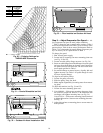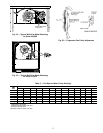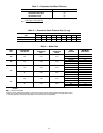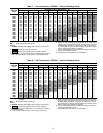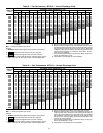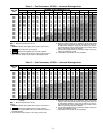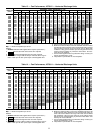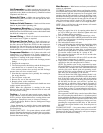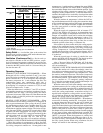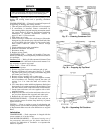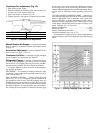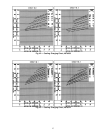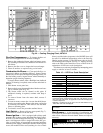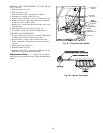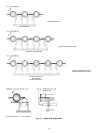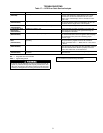
Table 15 — Altitude Compensation*
ELEVATION
(Ft)
125,000, 180,000, AND
224,000 BTUH
NOMINAL INPUT
250,000 BTUH
NOMINAL INPUT
Natural
Gas
Orifice
Size†
Liquid
Propane
Orifice
Size†
Natural
Gas
Orifice
Size†
Liquid
Propane
Orifice
Size†
0-2,000 31 41 30 38
2,000 32 42 30 39
3,000 32 42 31 40
4,000 32 42 32 41
5,000 33 43 33 42
6,000 34 43 34 43
7,000 35 44 35 43
8,000 36 44 36 44
9,000 37 45 37 44
10,000 38 46 38 45
11,000 39 47 39 45
12,000 40 47 40 46
13,000 41 48 41 47
14,000 42 48 42 47
*As the height above sea level increases, there is less oxygen per
cubic foot of air. Therefore, heat input rate should be reduced at
higher altitudes.
†Orifice available through your local distributor.
Safety Relief — A soft-solder joint at the suction line
Schrader port provides pressure relief under abnormal tem-
perature and pressure conditions.
Ventilation (Continuous Fan) — Set fan and sys-
tem selector switches at ON and OFF positions, respec-
tively. Evaporator fan operates continuously to provide con-
stant air circulation. When the evaporator-fan selector switch
is turned to the OFF position, there is a 30-second delay be-
fore the fan turns off.
Operating Sequence
COOLING, UNITS WITHOUT ECONOMIZER — When
thermostat calls for cooling, terminals G and Y1 are ener-
gized. The indoor (evaporator) fan contactor (IFC) and com-
pressor contactor no. 1 (C1) are energized, and evaporator-
fan motor, compressor no. 1, and condenser fan start. The
condenser-fan motor runs continuously while unit is
cooling. If the thermostat calls for a second stage of cooling
by energizing Y2, compressor contactor no. 2 (C2) is ener-
gized and compressor no. 2 starts.
When the thermostat is satisfied, C1 and C2 are deener-
gized and the compressors and outdoor (condenser) fan mo-
tor (OFM) shut off. After a 30-second delay, the indoor
(evaporator) fan motor (IFM) shuts off. If the thermostat fan
selector switch is in the ON position, the evaporator motor
will run continuously.
HEATING, UNITS WITHOUT ECONOMIZER — When
the thermostat calls for heating, terminal W1 is energized. In
order to prevent thermostat short-cycling, the unit is locked
into the Heating mode for at least 1 minute when W1 is en-
ergized. The induced-draft motor (IDM) is then energized
and the burner ignition sequence begins. The indoor (evapo-
rator) fan motor (IFM) is energized 45 seconds after a flame
is ignited. On units equipped for two stages of heat, when
additional heat is needed, W2 is energized and the high-fire
solenoid on the main gas valve (MGV) is energized. When
the thermostat is satisfied and W1 and W2 are
deenergized, the IFM stops after a 45-second time-off delay.
COOLING, UNITS WITH DURABLADE ECONOMIZER
— When the outdoor-air temperature is above the OAT
(outdoor-air thermostat) setting and the room thermostat calls
for cooling, compressor contactor no. 1 is energized to start
compressor no. 1 and the outdoor (condenser) fan motor (OFM).
The indoor (evaporator) fan motor (IFM) is energized and
the economizer damper moves to the minimum position. Upon
a further call for cooling, compressor contactor no. 2 will be
energized, starting compressor no. 2. After the thermostat is
satisfied, the damper moves to the fully closed position when
using an auto fan or to the minimum position when using a
continuous fan.
When the outdoor-air temperature is below the OAT set-
ting and the thermostat calls for cooling, the economizer damp-
ers move to the minimum position. If the supply-air temperature
is above 57 F, the damper continues to open until it reaches
the fully open position or until the supply-air temperature
drops below 52 F.
When the supply-air temperature falls to between 57 F
and 52 F, the damper will remain at an intermediate open
position. If the supply-air temperature falls below 52 F, the
damper will modulate closed until it reaches the minimum
position or until the supply-air temperature is above 52 F.
When the thermostat is satisfied, the damper will move to
the fully closed position when using an auto fan or to the
minimum position when using a continuous fan.
If the outdoor air alone cannot satisfy the cooling require-
ments of the conditioned space, economizer cooling is in-
tegrated with mechanical cooling, providing second-stage
cooling. Compressor no. 1 and the condenser fan will be en-
ergized and the position of the economizer damper will be
determined by the supply-air temperature. Compressor no. 2
is locked out.
When the second stage of cooling is satisfied, the com-
pressor and OFM will be deenergized. The damper position
will be determined by the supply-air temperature.
After a 30-second delay, the IFM shuts off. If the ther-
mostat fan selector switch is in the ON position, the IFM
will run continuously.
COOLING UNITS WITH PARABLADE ECONOMIZER
— When the outdoor air is above the enthalpy control set-
ting, and the room thermostat calls for cooling, the compres-
sor contactor no. 1 is energized to start compressor no. 1 and
the outdoor (condenser) fan motor. The indoor (evaporator)
fan motor is energized and the economizer damper moves to
the minimum position. Upon further call for cooling, com-
pressor contactor no. 2 is energized, starting compressor
no. 2. After the room thermostat is satisfied the damper will
spring return to the fully closed position.
When the outdoor air is below the enthalpy control setting
and the thermostat calls for cooling, the economizer outdoor
air damper is opened proportionally to maintain between 50
and 56 F at the mixed air sensor. If outside air alone cannot
satisfy the cooling requirements, economizer cooling is in-
tegrated with mechanical cooling and the second compres-
sor is locked out. When the room thermostat is satisfied, the
damper will spring return to the fully closed position.
HEATING, UNITS WITH ECONOMIZER — When the ther-
mostat calls for heating, terminal W1 is energized. In order
to prevent thermostat short-cycling, the unit is locked into
the Heating mode for at least 1 minute when W1 is ener-
gized. The induced-draft motor is then energized and the burner
ignition sequence begins. The indoor (evaporator) fan motor
(IFM) is energized 45 seconds after a flame is ignited and
the damper moves to the minimum position. On units equipped
for two stages of heat, when additional heat is needed, W2
is energized and the high-fire solenoid on the main gas valve
(MGV) is energized. When the thermostat is satisfied and
W1 and W2 are deenergized, the IFM stops after a 45 sec-
ond time-off delay. The economizer damper then moves to
the fully closed position. When using continuous fan, the
damper will remain in the minimum position.
24



